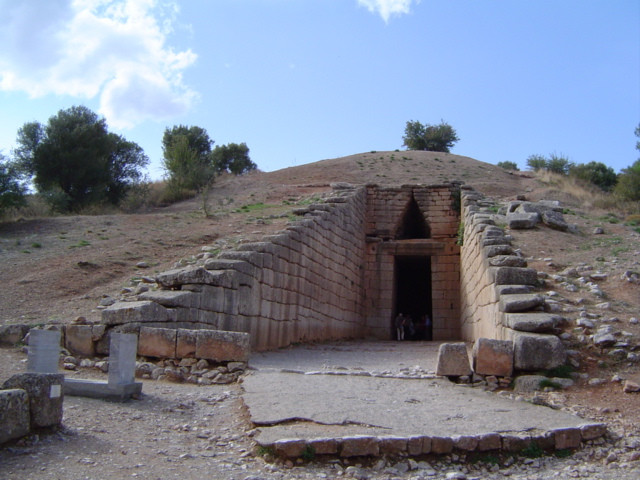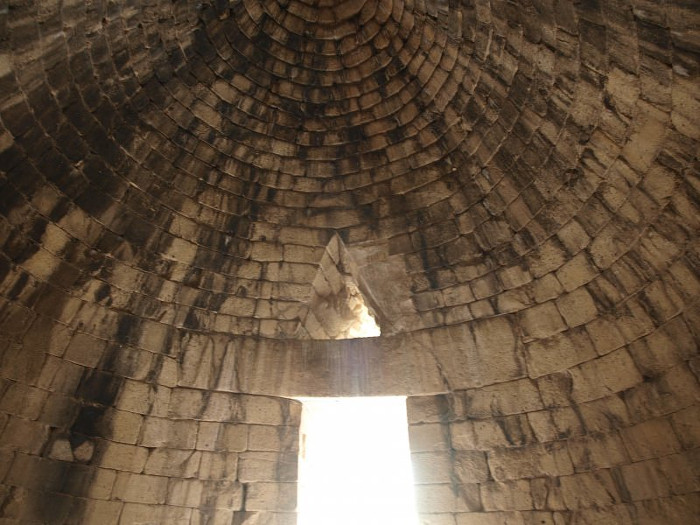Discover the mysterious tomb without any corpse
Called the honeycomb tomb, archaeologists did not find any of them.
The ancient tombs have a dome-shaped structure , often referred to as a honeycomb tomb found in many parts of the world.
The strange thing about these ancient tombs is that they are not used for burial purposes.
The most impressive structure of these honeycomb tombs is probably the Tomb - Atreus's Treasure , often called the Tomb of Clytemnestra in the history of Mycenae Greece.

Entrance of the Atreus Treasure.
It was built around 1350-1250 BC, and it is the only surviving structure of the Mycenaean civilization .
This tomb has a diameter of nearly 15m; Huge stone supports of the main door weighs 120 tons, 9m long, 5m wide and 1m high. Above the support beam there is a triangle shaped space.
All of the stone used to build the tombs were polished, and the façade was decorated with red and green jade stones.
To build a honeycomb mausoleum, it takes a lot of time and effort. However, when completed, people do not see any of them. However, it is still one of the most impressive "tomb" structures in Greece.

Inside the tomb.
Atreus's honeycomb mausoleum is the tallest and tallest dome in the world for over a thousand years, until Rome's pantheon.
Not far from the ancient city of Seuthopolis of ancient Thrace , Bulgaria, we will see graves built with honeycomb bricks in Kazanlak.
The tomb consists of a narrow hallway and a circular burial room placed in a large cemetery of Thrace people. Both hallways and grave rooms have murals depicting funeral rites.

Thrace people in Kazanlak look from the outside.
This mural makes it impossible to forget the description of beautiful and special horses in which the couple sat on horseback farewell, in which the couple held each other's hands in the most cuddly moment.
These paintings are an artistic masterpiece of Bulgaria from ancient Greece, and are still well preserved. This tomb was built in the 4th century BC and was discovered in 1944.
In 1979, UNESCO recognized the Thrace Tomb of Kazanlak as a world heritage. In Oman, an ancient honeycomb tomb was built around 3500 - 2500 BC.

Graves of bees in Oman.
However, scientists did not find any remains in these tombs and they were not ranked among the buildings.
They are somewhat similar to the Aegean circular tombs - built entirely on the ground and without the same three-part structure - the entrance is usually an unformed part of the circular tomb.
In Sudan, in the 17th century there were tombs of Tholo s tomb- like architecture, called Qubbas , or Koubbas, built of mud bricks.
Many honeycomb-like stone structures have also appeared in the eastern United States, probably originating from the American aborigines.
More than a century ago, archaeologists from the Smithsonian Institute discovered the mysterious cemetery filled with honeycomb graves in the Caldwell district of North Carolina, Sulliva county in Tennessee and Lickingy district in Ohio.
Strangely, although archaeologists found broken pieces of pottery, they did not see any remains in these tombs.
In Peru's Lake Titicaca area there are many ancient sites, where ancient structures called Chullpa burial towers were discovered.

Sillustani Tomb in the High Plains, Peru is placed above Umayo Lake.
Chullpas tower has a wide diameter at the top and tapers down at the bottom, like a funnel. It is thought that the mysterious Chullpas tower has small doors suitable for preserving crops, so it is used as a grain storage cellar.
There are several other scientific views; It is thought that this tower is used as a burial room.
Many historians argue that to build these beehive tombs, it is necessary to mobilize all efforts: workers, architects, sculptors, . and most of all, extremely tough leaders. "cold blood".
It is also often said that these ancient architectures originated in ancient Greece and were a driving force of the Post-Bronze Age period.
However, the origin and development of these beehive graves has yet to be answered. The real mystery of the beehive grave is that these "tombs" have no trace of human remains.
- Mysteriously sleeping beside the mysterious tombs
- The tombs are the most mysterious in the world
- Discover the mysterious 'watchman' tomb in Egypt
- Find remains in the mysterious tomb of Alexander the Great
- Discover the mysterious tomb on the island of the refugees
- Scary discovery about 1,400-year-old 'tomb of ghosts'
- The mystery of a 300-year dead body does not degrade
- Discover treasure in the tomb of Qin Shihuang
- Discovered a 1300-year-old Tiwanaku tomb
- Mysterious 'mystical' burial place 4,000 years old in England
- Mysterious giant whale corpse found in the Brazilian jungle
- Mysterious tomb headless of ancient Mayans
 Discovered an ancient centipede fossil 99 million years old
Discovered an ancient centipede fossil 99 million years old Discovered bat-like dinosaurs in China
Discovered bat-like dinosaurs in China Discovered a 200-year-old bronze cannon of the coast
Discovered a 200-year-old bronze cannon of the coast Discover 305 million-year-old spider fossils
Discover 305 million-year-old spider fossils